|
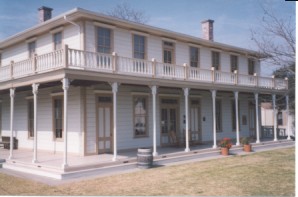 For
your enjoyment and to illustrate quilts that were popular in the 1920s
and 30s, what follows are pictures from an exhibit I curated in 2002 for
the Conjeo Valley Historical Society's Museum, the Stagecoach Inn. James
Hammell built a luxury Inn for travelers going from Los Angeles to Santa
Barbara. He named it the Grand Union Hotel, which cost him about $7,200
in 1876. Today it takes about 2 hours to travel that distance. It passed
through many hands and took on a wide variety of purposes until
becoming a museum in the 1960s. Unfortunately, a fire in 1970 destroyed
the original building made of redwood lumber from Northern California.
This one was built to replicate it on the original sites and was
dedicated and opened on July 4, 1976. For
your enjoyment and to illustrate quilts that were popular in the 1920s
and 30s, what follows are pictures from an exhibit I curated in 2002 for
the Conjeo Valley Historical Society's Museum, the Stagecoach Inn. James
Hammell built a luxury Inn for travelers going from Los Angeles to Santa
Barbara. He named it the Grand Union Hotel, which cost him about $7,200
in 1876. Today it takes about 2 hours to travel that distance. It passed
through many hands and took on a wide variety of purposes until
becoming a museum in the 1960s. Unfortunately, a fire in 1970 destroyed
the original building made of redwood lumber from Northern California.
This one was built to replicate it on the original sites and was
dedicated and opened on July 4, 1976.
Medallion quilts were not
the only style made in the 1920s and 1930s. Block styles, pieced and
appliquéd, embroidery, and foundation quilts, such as the pickle
dish, were in this exhibit. Many were made from patterns featured in
newspapers and magazines. Starting in the teens and growing from the
1920s to the 1940s, newspapers and magazines across the country printed
quilt
and
block patterns, pieced or appliquéd. Some included
directions for the entire quilt, others only for the block, and some
just had a picture of a block. This was more common in needlecraft
magazines. Some may have been sold as kits. Women ordered patterns and
kits through the mail, similar to our popular block-of-the-month
programs today.
The Colonial Revival brought back a desire
to make quilts, not the necessity. Women had less time to spend
on needlecrafts now, making kits and patterns ever more popular with the
masses. Kit quilts were made throughout most of the 20th century, and
are gaining popularity once again in the 21st century. The kits sold
today usually comprise the pattern, instructions and fat quarters or
half yards, rather than pre-cut or pre-marked fabric, since most
quilters use rotary cutting techniques.
 In the picture
to the left, I
am standing with Rosalind Webster Perry (right). Rosalind is the
granddaughter of Marie Webster. We are standing near Rosalind's quilt
named French Baskets. Although the maker of this quilt is
unknown, it is a pattern her grandmother designed around 1914, with
daisies rather than roses in the baskets. This version was published in
Ladies Home Journal in 1918 and became one of her most popular
designs. Many pattern companies copied it in the 1920s and 1930s,
selling it under different names such as Garden Baskets or Ivory Basket.
Rosalind estimates this quilt was made in the 1930s, possibly from a
kit. It is done all by hand, with the baskets in reverse appliqué. It is
made of cotton and measures 86" x 96." In the picture
to the left, I
am standing with Rosalind Webster Perry (right). Rosalind is the
granddaughter of Marie Webster. We are standing near Rosalind's quilt
named French Baskets. Although the maker of this quilt is
unknown, it is a pattern her grandmother designed around 1914, with
daisies rather than roses in the baskets. This version was published in
Ladies Home Journal in 1918 and became one of her most popular
designs. Many pattern companies copied it in the 1920s and 1930s,
selling it under different names such as Garden Baskets or Ivory Basket.
Rosalind estimates this quilt was made in the 1930s, possibly from a
kit. It is done all by hand, with the baskets in reverse appliqué. It is
made of cotton and measures 86" x 96."
 Marie Webster had a major hand in the revitalization of the quilting
movement, and she was one of the first woman in America to build a
cottage industry from her quilting. Marie was a quiltmaker, then a
designer, and finally an entrepreneur in quilt patterns and kit making.
She authored the first book dedicated to the history of quilts, "Quilts:
Their Story and How to Make Them," in 1915.
Marie Webster had a major hand in the revitalization of the quilting
movement, and she was one of the first woman in America to build a
cottage industry from her quilting. Marie was a quiltmaker, then a
designer, and finally an entrepreneur in quilt patterns and kit making.
She authored the first book dedicated to the history of quilts, "Quilts:
Their Story and How to Make Them," in 1915.
Rosalind, with
Marti Frolli, has written two books about her grandmother's story, which
include wonderful pictures of the original quilts featured in the
Ladies Home Journal, the history of the designs, and patterns for
today's quiltmaker:
"A
Joy Forever: Marie Webster's Quilt Patterns" and "Marie
Webster's Garden of Quilts."
After
Rosalind spoke to us about her grandmother's life, we had a book
signing. It was a perfect setting. We were surrounded by quilts
made from Marie's patterns. Marie's original quilts are in different
collections, private and at the Indianapolis Museum of Art. Some will be
at The Quilter's Hall of Fame, now located in Marie's former homestead
in Marion, Indiana. Rosalind lives with her husband in Southern
California, just a short drive north of my home. They both write books
on a variety of subjects and own a small publishing company. Like
Grandma like granddaughter!
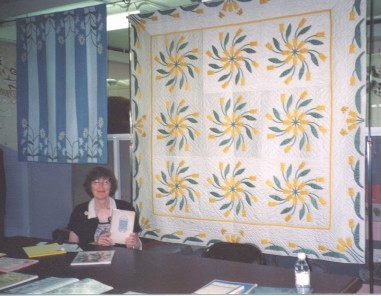 The
child's quilt hanging on the left in the photo is named Daisy.
This Marie Webster design was first published in the Ladies' Home
Journal in 1912, with this poem : The
child's quilt hanging on the left in the photo is named Daisy.
This Marie Webster design was first published in the Ladies' Home
Journal in 1912, with this poem :
"Teach the little one to
tell the petals of the daisy- 'loves me, loves me not'- and many happy
moments will be spent in finding out whether the child or his mother
loves the more."
Daisy was hand appliquéd and quilted by Santa Barbara quiltmaker,
Zetta Hanna, in 1991, using Webster's original pattern and color
choices. It is 50" x 60." The quilt on the right in the photo is
named Wind Blow Tulips and is one of Marie's first designs,
published in the Ladies' Home Journal in 1911. Stearns & Foster
printed a similar pattern on their Mountain Mist batting wrappers in the
1930s.

This quilt was purchased in 1988 in Indiana, but nothing of its history
is known. The maker is unknown. She made it with cotton sateens, and
beautiful appliqué and quilting patterns. It measures 80" x 80."
We were thrilled when Rosalind brought one of the rare quilts actually
made by Marie. It is a summer spread called Dutch Baskets. It is
unquilted and made of one layer of muslin. Marie made a pair of these in
the 1920s. She also made a kit of this design, which included all the
fabric needed. It was available for $8.50 as a spread and $10.00 as a
quilt.
BUTTERFLY
MEDALLION ca 1920
Cotton, hand appliquéd and quilted, embellished
with embroidery stitches and rickrack. Owned by Beverly Viola, Westlake
Village, CA. 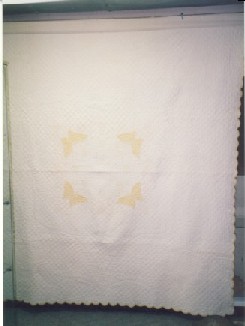
In the 1920s and
1930s, it was not unusual to use buttonhole, chain and stem stitching,
French knots, and other embroidery stitches. The butterflies on
this quilt are embellished with a thicker-than-usual thread, which is
likely a pearl cotton. The edges are held down with white rickrack and
yellow French knots at the top of the curved points. Rickrack was used
in aprons and table linens but seldom seen on quilts. Placing the
motifs in the center, surrounded by lots of quilting, including the
feathered garlands, make this a medallion-style quilt within the
Colonial Revival quilt styles.
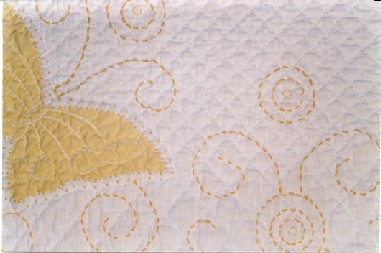
Beverly Viola loaned the exhibit another medallion quilt, GRAPE VINE
MEDALLION, ca 1925, which she believes probably originated in
Colorado Springs. It is made of cotton, hand appliquéd and quilted.
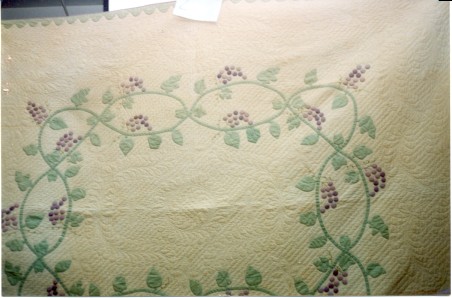
The quilting is the most
eye-catching feature of this quilt, in spite of the grape and leaf vine.
It is outstanding, as the feathers curve around, starting in the center
as a wreath and forming frames inside and outside the vines. Four
leaves form a flower around the inner medallion, and diagonal lines fill
all the remaining space. The areas that are raised have been
stuffed with batting from behind to create more depth. Stuffed
work, or trapunto, is a very early technique that began in Europe.
This quilt does not appear to be a kit, but it may be from a
pattern. The scallop edge of green (seen at top left edge) is a
20th century adaptation of the 19th century sawtooth border.

Julia Beedon, from Moorpark, CA, is standing beside her family's
quilt, DANCING DAFFODILS VARIATION, ca 1930. Julia Sarah Eslinger
(1864-1957) made this quilt in Wilson, Kansas. Julia Sarah Sellers was
born and raised in Pennsylvania. She married George Eslinger on
September 25, 1888, and they homesteaded a farm in Kansas where they
raised three children. The farm has remained in the family ever
since. The quilt came to CA in 1987. It is made in cotton sateen, hand
and machine pieced, hand appliquéd and quilted.
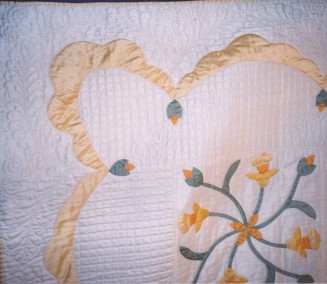 This
appliquéd swirl of daffodils and buds is similar to a design by Marie
Webster called the Wind Blown Tulips, which was pictured
in Ladies Home Journal in January 1911. Stearns and Foster
(S&F) adapted it to make their daffodil quilt sell as a 'Mountain Mist'
pattern. S&F placed their colorful quilt patterns on their batting
wrappers, beginning in 1929. This
appliquéd swirl of daffodils and buds is similar to a design by Marie
Webster called the Wind Blown Tulips, which was pictured
in Ladies Home Journal in January 1911. Stearns and Foster
(S&F) adapted it to make their daffodil quilt sell as a 'Mountain Mist'
pattern. S&F placed their colorful quilt patterns on their batting
wrappers, beginning in 1929.
Marie Webster designed a daffodil
quilt in the late 1920s called Rainbow. It included a geometric
border inspired by the Art Deco period, whereas this border of soft
boughs is a 20th century stylized version of mid -9th century appliquéd
borders.
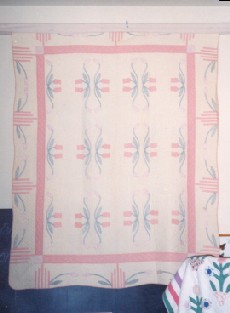
Julia Eslinger made this stylish, Art Nouveau/Deco transition
quilt earlier, ca1925, with help from the Presbyterian Church quilters
in Kansas. Which parts each did is unknown.
The graceful curves
of the tulip stems and long shapely leaves are the Art Nouveau aspect,
which is juxtaposed by the straight, then angular rectangles, a motif
seen time and again in the chrome and metals of the Art Deco period.
Perhaps this tulip pattern appealed to her Pennsylvania roots.
Embellishment with
embroidery was commonly seen on quilts, thanks to the many different
patterns being printed in newspapers across the US. Rosemary Kent, from
Valley Village, CA, loaned the exhibit one of the more unusual
embroidered quilts one might have seen in the 1920s.
  The
FOXY LADY was more likely to be seen on a hand towel than a
quilt. Rosemary received this quilt from her mother-in-law, Helen Kent,
who grew up in Kansas City, KS. Although not a quiltmaker herself, she
appreciated them and probably bought it while living there. The
FOXY LADY was more likely to be seen on a hand towel than a
quilt. Rosemary received this quilt from her mother-in-law, Helen Kent,
who grew up in Kansas City, KS. Although not a quiltmaker herself, she
appreciated them and probably bought it while living there.
This Foxy Lady is set in
the center of a Harlequin background, which is further defined by the
selection of solid colored diamonds. The "inner border" is set in
pinks and gold, with the other corners in blues and whites. There are
two wide borders, one is pink and the other is white. It is machine
pieced and machine quilted, which is unusual for that day. The appliqué
and embroidery is done by hand, and it is all in cotton.

Rosemary is the
great-great-granddaughter of quilter Fannie Edwards (9/2/1861 to
4/4/1941) who appliquéd this quilt top, MEADOW ROSE BOUQUET in
the 1930s, with her granddaughter, Margaret Ann Edwards (Olds). Margaret
was born September 9, 1917, while they lived in Indiana. A church
group in Pomona, CA, quilted it at Margaret's request, around 1970.
Bouquets tied with a single looped bow are an unusual design
element. Colonial bouquets would have been placed in a basket or urn,
and bows usually had two loops, sometimes three petals. Primroses
sprinkled about are also an unusual creative touch. They fill
empty space without distracting from the main blocks. The very thin 1/8"
binding is reminiscent of colonial quilts, but this binding is applied
in part by machine.
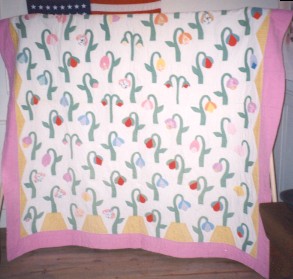 Susan
Fox, from Westlake Village, CA,
purchased CORAL BELLS, ca
1930s. It is hand pieced, appliquéd and quilted, in cottons. Susan
Fox, from Westlake Village, CA,
purchased CORAL BELLS, ca
1930s. It is hand pieced, appliquéd and quilted, in cottons.
Notice the unusual border treatment on this quilt. The top and bottom
are one design, the sides another. On the bottom row, the shape serves
as a bold vase for the stemmed flower.
The flower is typical of the appliqué patterns found in magazines
and newspapers during the 1920s and 1930s. Often, a different flower
would be put in a series of patterns, printed over time in these
periodicals. There are two different patterns seen in this one.
There is not much quilting, as the flowers were the emphasis for
this quilt maker. She was carefree in placing which way the flowers
face, adding a whimsical quality to this quilt.
New Pathways into Quilt History written by Kimberly Wulfert, Copyright 2004
Kimberly Wulfert, PhD, with permission to use the photographs from the
quilt owners and museum. All rights reserved.
Continue to
page two . . .
|